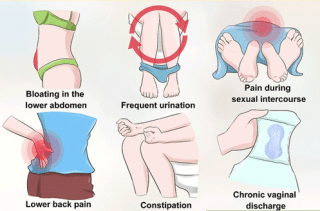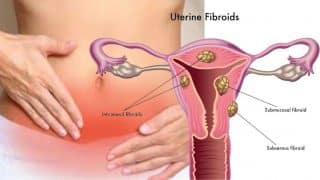UTERINE FIBROIDS & INFERTILITY
(Non surgical - Utereine fibroid embolization)
Now a days infertility is the most increasing problem in young couples. Reasons being the altered life style, food habits, work related stress to the already existing factors. Symptomatic Uterine Fibroids are most commonly noted in young females of 20+ years of age.
A number of couples experiencing infertility problems has increased over the past years. Both male and female factors contributing to it. More Particularly in women, several factors play a major role in affecting ability to get pregnant.
Now adays most commonly problem is uterine fibroid, noticed even in younger age groups. Uterine fibroids are noncancerous (benign) growths of the uterus. And these can potentially cause infertility by blocking the fallopian tubes or stopping a fertilized egg from implanting in the uterus. In addition, large fibroids may prevent a fetus from growing fully. Fibroids can result in increased risks of placental abruption and resulting in premature birth/ miscarriage due to compromised oxygen and nutrient supply.


There are four primary types of fibroids according to location.
- Subserosal fibroids:
- Intramural fibroids:
- Submucosal fibroids:
Possible Causes And Risk Factors
Although definite causes of uterine fibroids remain unknown, clinical researches point to these relevant factors:
- Hormones. Estrogen hormone significantly appears to promote the growth of uterine fibroids.
- Heredity.Uterine fibroids seem to run in families.
- Obesity.two to three times greater in obese women due to to higher estrogen
- Food habits and lifestyle .
Diagnosis Of Uterine Fibroids
include abdominal ultrasound, vaginal ultrasound and hysteroscopy. In some cases, other imaging tools such as MRI might be further required.
Book An Appointment
Symptoms Of Uterine Fibroids
Some women may not experience any symptoms. In those that do, symptoms can be influenced by the location, size and number of fibroids. The most common signs and symptoms of uterine fibroids include:
- Heavy and prolonged menstrual bleeding;
- Irregular bleeding between menstrual periods
- Frequent and incomplete urination
- Constipation
- Back pain, lower abdomenand leg pain
- Bloating / distended abdomen
- and infertility.
Complications Caused By Uterine Fibroids
Uterine fibroids if they continue to grow and become bigger, they may lead to a wide range of complications such as impaired fertility, severe pelvic pain
and heavy bleeding which eventually causes anemia. Particularly in pregnant women, untreated fibroids might lead to:
- Miscarriage
- Preterm delivery
- Fetal malpresentation described as wrong fetal body position
- Heavy bleeding after giving birth (postpartum hemorrhage)
Treatment Of Uterine Fibroids
it is entirely determined by location and size as well as presenting symptoms and individual’s conditions.
Medications for treating symptoms However, medicines do not eliminate fibroids.
Surgeries to remove fibroids is either hystrectomy or selective fibroid removal is myomectomy. which is an open surgery / laproscopy.
Whereas uterine fibroid emboliztion is a non surgical, day care angiography method where no surgical cutting / no sutureing / no opening / no anesthesia is required, hence no blood loss, no infections, no complications.
More importantly, faster recovery time and shorter hospital stay enable patients to quickly return to their daily life and activities.
The patient gets admitted on the day of procedure, gets it done and mostly may leaving by the end of the day or at the most next day. And can resume daily activities the next day and can go to work the next day.
The symptoms will get relieved within fewdays to weeks. However the size of the fibroid will take few weeks to 2-3 months to significantly reduce in size.
FAQ
Pt can plan for family with a minimum period of 6month post procedure.
it is rare for treated fibroids to regrow or for new fibroids to develop after uterine fibroid embolization
Number and size does not matter in treatment by this method. Any number and any size can be treated in one sitting.
It is not at all a surgey. It is just a simple angiography kind of procedure with an iv cannula kind of line in the groin or hand where the pt is all awake with no pain and can see whats happing on the monitor throughout the procdure.
It normally takes not more than 30min. For the procedure
The fibroif usually shrinks inside the body over a period of time or gets discharged sometimes as products pervaginally
It is not worth removing the complete ueterus when the fibroid is a just a benign growth. As utereus has other hormonal functioning to maintain a balance in the body and also to keep the pregnancy option open atleast in the child bearing age. And as for moymectomy is again a surgical / minimal surgical procsdure.
Thesre may be disturbance in the cycles for a month or two, with gradually gets normalise thereafter.
There are no absolute major complications associate othere than just fever, pain kind of symptoms for a day or two.
They are present in almost 1 in every 3 women. Symptomatic or non symptomatic. But in symtomatic women it definatly needs to be attended and treated to prevent anemia, pregnancy complications and infertility.
Here a small iv cannula kind of tube is placed in the groin and tube is selectivey passed into utereus via blood vessel and some particle like medication is injected into the fibroid selectively, cutting off the blood supply to fibroid resulting it to shrink over a period of time.
